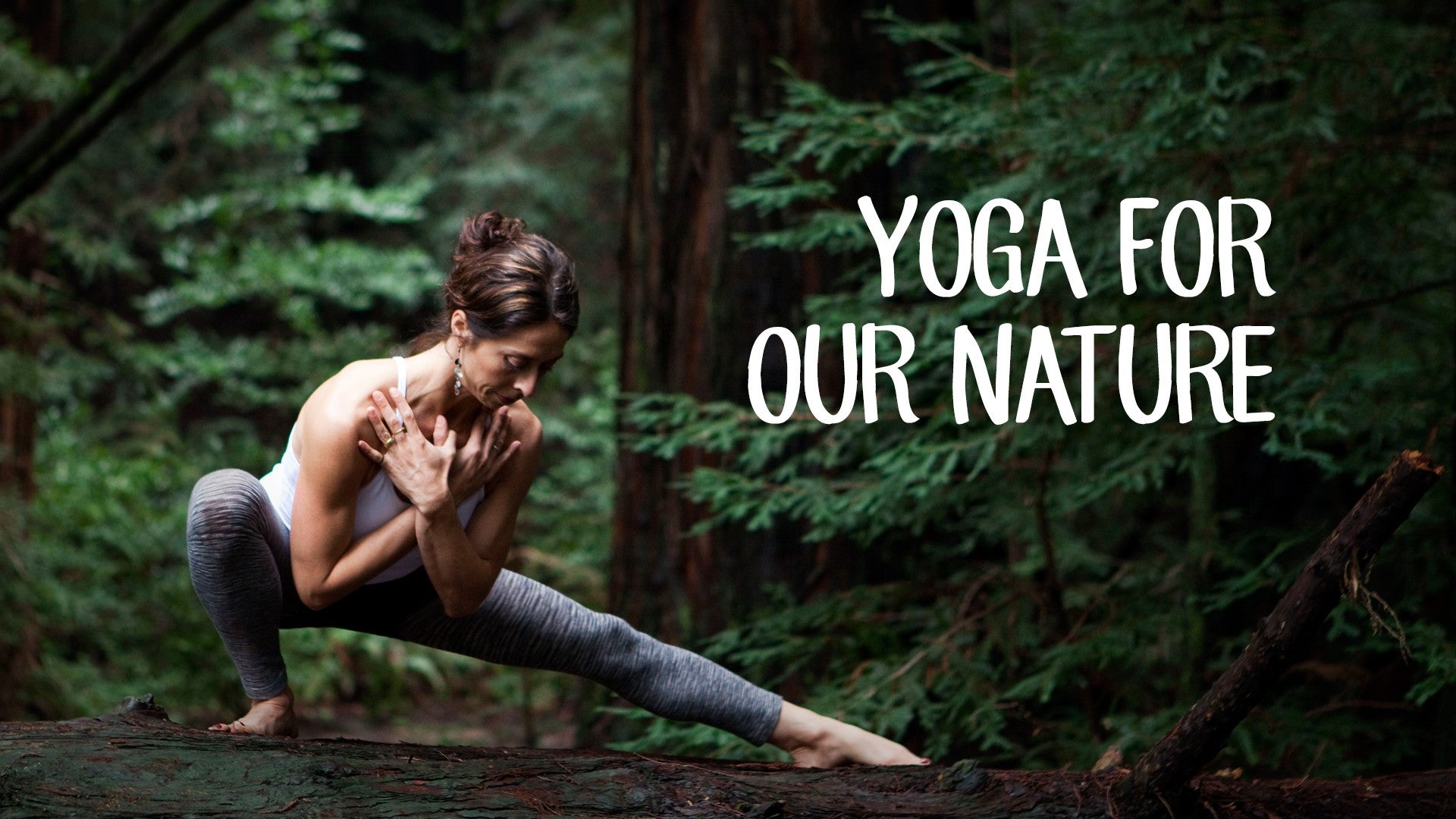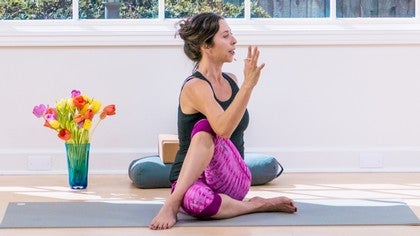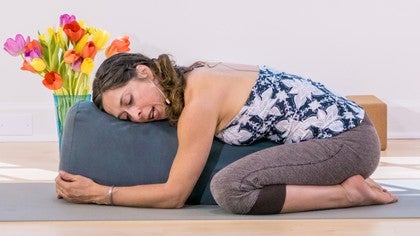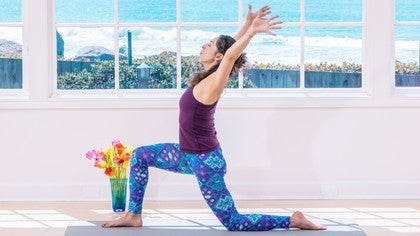Description
About This Video
Transcript
Read Full Transcript
(waves crashing) Namaste and welcome to our second pillar talk and practice on sleep. So without sleep on a regular basis, or irregular basis, you might notice that you have more challenges in your daily life, dealing with stress, with coordination, energy levels, weight management, the immune system gets compromised and the list continues to go on, so you can see how important it is to take care of our life in a way that allows us to sleep well. So, different constitutions might have different reasons as to why that we aren't sleeping regularly. Ayurveda instance, it might be somebody has too much going on, there's excessive movement in their life. Oftentimes it's more of a pitta dosha imbalance and it's more of a burnout symptom.
If it's more of a kapha constitution, oftentimes there's some energetic block, which might prevent someone from actually sleeping well. So, you might be wondering, what can you do to help improve the quality of your sleep, and the list goes on and on and on of what we could do together to look at the most effective practice and what I wanna share is just a few of the things that I found really effective, working with client's and in phases where I've had some insomnia and the first thing I would like to suggest is to try to establish a routine in your life. The more routine your life is, the less tracking you have to do of keeping track of things, which creates that excess activity of the mind. And particularly, you're trying to establish routines about bedtime and when you wake up. That would be probably the biggest priority for routine and the body tends to respond pretty well to that.
And another thing you would want to try to do is to try to eliminate eating late at night. Sometimes when the body is actually digesting the dinner you just had, you're trying to sleep, that digestive process is interrupting your sleep, especially if dinner is followed by any desert or alcohol, that that can really interfere with your ability to go into that deep sleep, which will help you feel really refreshed in the morning. So that's a couple things, top of my list that I usually recommend people do. If you drink caffeine through any sleep disturbance phase that you try to eliminate all caffeine entirely, or if you're starting to have more of a headache and worry about caffeine withdrawals, that instead of having a whole cup of coffee, you would just have a half a cup of coffee and then after a half a cup of coffee for a few days have a quarter cup and try to again, slowly, gradually eliminate that from your daily practice until you're back to normal sleep. Another thing is to try to prepare your bed space like you were gonna take an eight-hour long Shavasana.
So you wanna have really an abundant supply of pillows, soft bed, perhaps for some of you, you need a firmer bed, but to make sure that your bed feels like a nest and that you have the right amount of support to be comfortable, cause sometimes we find maybe you're waking up because you feel stiffness in your hip or in your shoulder from not having enough support, so making sure you have good support in your bed might help with better sleep. Keeping all electronic devices, I know that might not be as easy as it sounds these days, but to try to keep them out of the room. So, before you enter your bedroom, electronic devices are turned off and if any little light sources are irritating you, or waking you up, just to be aware, to really block out all light sources, which include, for some people, maybe alarms or sensors and there'll be a green or red light that might be really irritating to someone with insomnia, so try to block out any place where light is coming in, to have really dark shades, curtains, to block out the external light from street lights and things like that, if you're sensitive to sleep, that can definitely help. Couple other things that can help people often sleep better is throughout the day, number one, avoid taking naps. So, oftentimes we might think that taking a nap is a good idea, but we might notice that we're actually taking naps and then staying up later in the evenings, so the priority that we would try to encourage you to create, the priority of going to bed earlier so that you don't have the desire to actually take a nap.
And then, in your day, to try to make sure that you have some exercise outside, so that you're receiving some natural sunlight and you're moving your body, breathing well, rhythmically and eliminating perhaps some of the mental stress by getting exercise every day can make a huge impact on improving your sleep. And then one of the more subtle things that you can do is when you're going to bed, I think I heard this from Claudia Welch, where she talks about trying to leave all your worries to God when you go to bed, so that we're not imagining that our role in life is greater than it is and so sometimes maybe we feel like the world is gonna fall apart if we disappear into sleep land for a little bit and she's helping us remember that, you know, leave your worries to God, the world is gonna be okay if you're sleeping. And the world will typically be a better place when you participate after a good night's sleep. So, in addition to all that, there's a lot of great science out right now that is describing the actual cleanse that happens in your brain when you sleep, so it's important for our brain to also get rest, which is why we wanna turn our worries over to God at some point in the day and at night when you're sleeping, the cells in the brain shrink, so more fluids come in to wash out the protein build-up that happens from your day of thinking all day and planning all day. And that detoxification, that cleanse, doesn't happen when your mind is active, so that deep cleansing happens actually when you sleep and hopefully that helps you again feel sharper and more attentive in the morning, when you wake up from a good night's sleep.
So, the other piece that we can do is work at Asana, so I wanted to offer a practice that has some simple Asanas that you might just find yourself actually doing in bed, if you wake up. I encourage people, if they wake up in the middle of the night, to actually try to stay in bed, not to get up, not to do any activities. And so we're gonna go through a couple different practices using a breath technique, as well as using a mantra to recite, to try to lull the mind into sleep and to give your mind one object to focus on, rather than the mind focusing on all the things that didn't happen in the day, all the challenges that we have to face the next day and try to focus on one thing at a time while we're in bed, hopefully trying to fall back to sleep. So, what we'll need for this practice is a bolster and a blanket and a block. And we're gonna begin simply with a blanket and I'm gonna have us take the blanket and just make a simple roll.
The blanket doesn't need to roll all the way into itself, three-quarters of the way is usually sufficient. And we'll have us just simply stretch the legs out and then take the blanket so it's down underneath the shoulder-blade area, so when you come to your back, your shoulders are supported and the arms just relax out to the side. So it's a little bit of a lift in the chest, if you close your eyes when you feel comfortable in the rest of your body and we'll start to focus on the feeling of air moving into your nose, down into your lungs. And what I'm gonna have you pay attention to is when you exhale all the air out, that that's the place we're gonna pause, at the end of your exhale. Okay, so you take your normal, steady breath in, and then we have a slow exhale and then we're gonna hold your attention for a moment after exhale.
And so know it's not a competition to see how long you can hold your breath out, it's just bringing awareness to the end of the breath and that little quiet space that exists, where there's no breath coming into the body. Hopefully there's a feeling of sinking, a little bit more into the present moment, when you pause at the end of your exhale. Oftentimes there's a recommendation for people to make their exhales a little bit longer than the inhales, if you're experiencing insomnia. And so there will be a counting to yourself, how long your inhale is and to try to make your exhale a little bit longer. A couple more rounds, keeping track for yourself of the length of your exhalation.
And then hopefully using that technique as often as you need to in your faces, potentially, with insomnia. And we try to come out, keeping the mind quiet, the body relax as you roll to your side, to release the blanket out from underneath your back. And as we put that away, we're gonna grab a bolster and if you were in bed, it might just simply be your pillow. It'll be a version of a Supported Bridge Pose, so if we allow the buttocks to come to the bolster area, and depending on the length of your torso, you might need to scoot further back, so that the head is on the ground, the shoulders on the ground, and, as if you were doing a Bridge Pose, to emphasize again, a little bit more opening of the chest area, a little bit lift of the hips, and the arms down at your side. And so again, we're encouraging the eyes to close as soon as you feel settled in your seat.
The bolster, again, you wanna feel this more towards the base of your shoulder blades. It's almost like you're doing a little Minor Shoulder Stand, just a little precursor to something like an Inversion. Let the weight of the body release into the support. And try to keep encouraging the earth element, the feeling of heaviness, if you're having insomnia, so you want to become as heavy like a rock and imagine that rock is sinking slowly down to the bottom of a lake. And if the body starts to feel heavy, oftentimes the mind will start to also slow down, perhaps become more stable.
Let's see if we can go back to use the technique of lengthening your exhale and take a little pause at the end of exhale. Just a few more breaths here, in this way, in our Supported Bridge. You could use pillows underneath your back, you could use a bolster underneath your back. And as we come up, we'll lift the body up, and slide the bolster out of your way, so you can have a flat, neutral spine for a moment, then when you're ready, we'll come up and we'll use that bolster again for a Supported Child's Pose. So we have the knees wide and we're gonna turn the bolster so it's tall, so rather than be on the flat edge, come up a little bit higher and you can maybe imagine in bed, just a few pillows underneath you for support.
If we press this front edge down a little bit, so that you come forwards, it eases us into that Forward Fold. Let your hands come down to the side, or we can hold the bolster, if it feels unstable, and then turn your head in a way that you can rest the head onto the bolster here. When you feel you've come to a stable place, let your whole body weight sink onto the bolster. Again, looking for that feeling of heaviness, maybe, again, with the arms slowly spreading out a little wider, away from the prop. And so we've introduced the idea of tracking the breath and encouraging the exhale to be a little longer than your inhale.
And another technique that I want to introduce is the concept of using a mantra, or word, or chant, or a phrase that you repeat while you're breathing in, while you're breathing out, to help the mind focus on one subject, one object, one thought at a time. So, either choosing a word that's meaningful for you. We might use a mantra like "ohm," as the basic one, when you're inhaling, to yourself, saying internally, "ohm." And when you exhale, "ohm." Every inhale breath is met with "ohm." And exhale, "ohm." You can use a simple word like "relax." So when you breath in, using the word "relax," and when you're breathing out, "relax." Until you might find yourself just drifting at the end of the word, the mantra, perhaps more into stillness, more into rest. And it's really important to get good sleep is that we learn how to rest, which is a precursor to sleep. And so what nightly activities can we do, like a little restorative yoga to help us rest so that we can sleep well.
Have a warm cup of chamomile tea before bedtime, so that you rest before you sleep. Explore your mantra, your word, a couple more rounds just to notice what that feels like. We'll try that same concept in the next shape. If you put your hands underneath your shoulder line, press your way up and as we come up, we're just gonna slide the bolster a little bit more forward and so with the bolster out in front of you, and bring your knees back, away from the bolster, almost like you're going towards a Downward Dog, Child's Pose-ish shape. Okay, so we're gonna walk the hands out in front of you and we'll let the forehead rest on the bolster's lower edge here.
Again, you could have a couple pillows under your head if you were doing this in bed. And just allow the head to really settle into the support. And let some of the pressure at the front of the head can help release some tension at the front of the mind. Okay, so we're relaxing the upper body. If there's any problems with the knees, you could have a pillow, or a blanket back behind the knees, so you can sit back in a good way.
Okay, see if you can return back to your word, your mantra as you're breathing in, and when you're breathing out. Giving your mind one task to do when breathing in, one task to do when breathing out. And you might find you drift off every now and then into your word, which is great. If you wake up startled, surprised in any way, just keep coming back to your word until you're ready to turn over and actually fall asleep. Okay, and then from here we're gonna try another shape as we lift the head up away from the bolster, walk the hands in.
And we're gonna simply use the bolster or pillows again. If you were to stretch your legs out in front of you, and then set this on top of your thighs. So I usually turn it a long way, so I've got support for the abdomen area, legs out long and a place to rest the elbows down, so that as I come forward, I can catch my head and again, just apply just gentle pressure to the front of the forehead area, to relax the front brain. And just allow again the eyes to close and to maybe notice which technique you prefer. Do you like to lengthen your exhale and hold the breath out?
Or do you like to follow the sound of a word, a mantra, a phrase? And coming the place, again, where you allow yourself to really feel heavy in the body. Not forcing the stretch, but simply finding a comfortable place to calm down. And just a couple more moments, experiencing what the shape might be like. Something that you could do right in your bed.
And making sure that if you're doing yoga in bed, again, we keep the lights out, we don't turn the lights on. Finishing maybe with this next breath and so we take the hands down and lift your spine up and then you might simply use the block, bolster again as you bring your feet together and then wedge the bolster into the inner leg area. And so now with the hips more apart for some people might also feel good and the same idea as we're resting the elbows on some height, bolster, pillows. Bring the hands to the forehead as we close the eyes and perhaps choosing one of the two techniques that work for you here. Lengthening the exhale breath, there's a little hold at the end of the exhale.
Or that meditative way, listening, following the sound of a mantra or a simple word. And releasing all of our worries to God, the divine, whatever that might be. Knowing that the world will be a better place if we get good sleep. We tend to be more patient. We tend to digest our food better.
And we tend to maintain stronger immune systems when we get good sleep. Alright, when you're ready, we'll finish that shape, with your hands once again reaching down to the bolster and then as we come up, and you might find that you complete the practice with the pillow underneath your head, or bolster under your head, and just setting up actually to try to go back to sleep and all done with the lights out. So I hope some of those techniques help to improve your quality of sleep and may others then also benefit from your practice. Namaste.
Yoga for Our Nature
Comments
You need to be a subscriber to post a comment.
Please Log In or Create an Account to start your free trial.

















